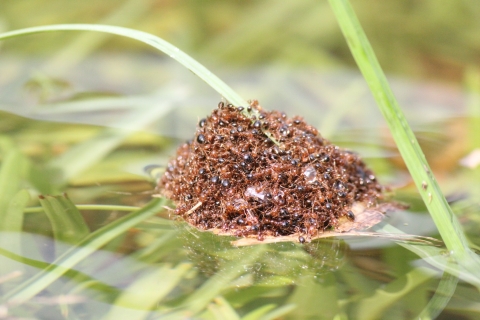In addition to causing widespread property damage and suffering, Hurricane Harvey in August 2017 also brought a plague of floating fire ants to the Houston region.
Flooding doesn’t drown fire ants, Texas A&M describes this deadly phenomenon in a pamphlet “Flooding and Fire Ants: Protecting Yourself and Your Family.” Colonies present a potentially serious threat to people and animals during times of flooding, as their stings can be fatal.
Whole colonies of the noxious biting red insects — including the young: eggs, and larvae — can survive floods. They emerge from their earthen lair — individual ants daisy chain together forming a sort of gelatinous insect blob. The spaces between their links are so small that it doesn’t break the water’s surface tension. This allows the colony to float. The ant raft follows the waters flow. Once the colony reaches a dry object (or person), individual ants break away and crawl onto the non-water surface. This is a dangerous prospect for people and animals in flooded areas.
In a flood situation, the floating ants must be dispatched immediately. This is best achieved by spraying them with a dish soap spray. The soapy water lowers the surface tension, drowning the ants. Texas A&M recommends two fluid ounces of biodegradable dishwashing liquid mixed with one gallon of water.
Treating the Invasive Fire Ants
The invasive fire ants developed their floating mechanism to survive in the floodplains in South America. Sometimes called ginger ants, they were inadvertently brought to port in Mobile, Alabama in the 1930s. The economic impact associated with red imported fire ants costs Texas’ economy around $1.2 billion each year.
While soaping down a flood-floating colony of the ants can wipe out the immediate danger for you and your family, this unpleasant species continues to plague the people and animals of the Southeastern U.S. long after flood waters recede.
One native animal that’s been especially affected by the ants is the endangered Attwater’s prairie chicken (APC). Endemic to the coastal prairies of Texas and Louisiana, this grouse species known for its elaborate dancing, once numbered up to one million birds. As farms, towns, and cities sprung up, the population diminished. By 1988, less than 1,000 remained in the wild.
The Attwater Prairie Chicken National Wildlife Refuge was established in 1972 just west of Houston. It was the proliferation of the red imported fire ants that had dealt a nearly final blow to the wild Attwater’s prairie chicken population. Because the wild chicken’s life span is short, successful reproduction is key. Not only do the ants prey directly on the birds, but they also prey on native insects eaten by young chicks. Due to this competition for food, Attwater’s prairie chicken chicks sometimes die of starvation.
The greatest gains in improving wild Attwater’s prairie chicken populations have come as a result of controlling the ants. After intensive study, refuge personnel began treating for fire ants in 2014. This has led to an increase in native insect populations, along with an increase in the survival rate for Attwater’s Prairie Chicken chicks to two weeks of age. Between 2012 and 2016, wild chicken numbers increased 170 percent, from 48 to 130 individuals.
Because the population is so small, great efforts are made to protect individuals from harm. When Hurricane Harvey threatened the Texas Gulf Coast, 20 captive-bred birds scheduled for release at the Refuge were returned to the Houston Zoo. Those birds are doing well, and gaining weight. More good news is that the Houston Zoo was spared the worst of Harvey’s effects.
While fire ants are well adapted for flood survival, the remaining wild Attwater’s prairie chicken population isn’t so resilient. Just last year, in April 2016, the Attwater’s prairie chicken refuge faced similar flooding, which hampered the reproduction of the 130 birds in the wild. Flood waters negatively impacted their nests on the ground.
Adult Attwater’s are strong flyers, and they seek out dry land when floodwaters pour into low lying areas. Their habitat is limited to the pristine coastal prairie of southeast Texas, and less than one percent of it remains. During flooding, their area is further limited to what’s still dry.
Unfortunately, the Attwater’s predators — such as coyotes, bobcats, raccoons, and snakes — are also flushed to the same slivers of dry land. Two years in a row now, the wild Attwater’s prairie chickens have been driven into small dry areas enriched with predators who take advantage of the circumstance to feed.
The flood waters resulting from Hurricane Harvey have now receded, and Attwater Prairie Chicken National Wildlife Refuge staff is assessing what’s left of the remaining wild population of this very rare dancing bird.







